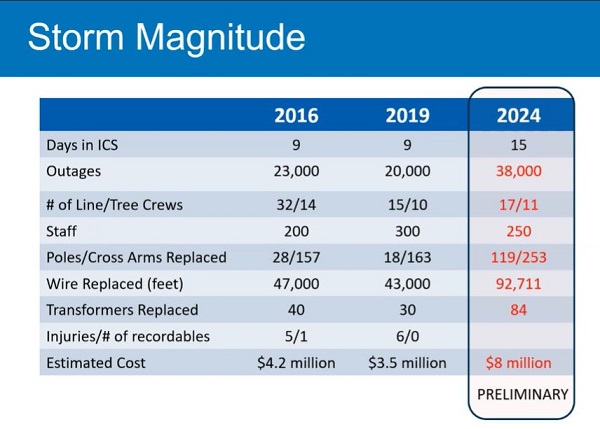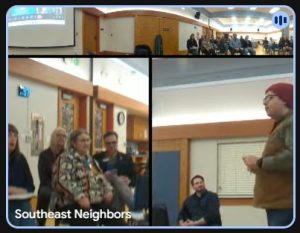EWEB: Ice storm response cost $8 million
11 min read
A preliminary assessment of EWEB’s ice storm response: The Eugene Water and Electric Board restored 38,000 services at a cost of $8 million. At the Feb. 6 board meeting:
[00:00:13] Frank Lawson (EWEB general manager): A few comments about the ice storm recovery. Now I will say these are preliminary assessments, but 38,000 services restored is significantly larger than what was referred to as Snowmageddon in 2019, and also the ice storm in 2016.
2016, there was an ice storm that was fairly localized, affected EWEB significantly, did not affect some of the utilities around us. This last ice storm (which was really two ice storms) not only affected EWEB significantly, but also EPUD, as we know, Springfield Utility Board, Lane Electric.
[00:00:56] Two hundred and fifty or more internal staff members responding and pretty significant when you look at just the fact that we replaced 92,000 feet of electric wire, and rebuilt it’s about one-third of our system, it seems like, over those two weeks.
[00:01:14] The rough estimate for the cost is about $8 million for the response. And we will potentially get three-quarters of that back through FEMA if all those processes go correctly.
[00:01:29] Sonya Carlson (EWEB commissioner): I am curious: Does the 38,000 number, is that, that’s customer lines, right? You know, out of our, what, 90,000 we have. We had 38,000.
[00:01:43] Frank Lawson (EWEB general manager): There were 38,000 restorations of different services. I can’t say that those were all unique 38,000. There might have been some that got hit by the first storm, we recovered them, we restored them, and then on that Tuesday night, they may have gone down again. But that is services. If you look at the average number of people impacted per service, it’s probably three. It’s probably 120,000 people were directly impacted.
[00:02:09] This event affected generation significantly and also our water department, and really the foresight of this board to approve the investment in resiliency at the Hayden Bridge water treatment plant prevented some of the issues that might have come up if we would’ve also in the middle of an ice storm restricted water use.
[00:02:33] Karen Kelley (EWEB chief operations officer): I had the opportunity to speak to the media yesterday about Hayden Bridge and how they survived the storm with the backup generators. And similar to when we had the chlorine shortage, it was critical that these kinds of decisions that are so forward-thinking and proactive to consider, you know what, maybe a, you may think it’s a low risk. And then it happens. And it’s like buying insurance for us is kind of how I described it, and it’s paid major dividends. So I just want to thank you all for your attention to these kinds of things and your support for all of us.
[00:03:08] Frank Lawson (EWEB general manager): And so we had pump stations that we had backup generation. We lost fiber communications, which is an important part of our protection systems.
[00:03:19] And probably the largest impact on transmission that we’ve seen: The main transmission line from Carmen-Smith (hydropower project) was impacted at a time when power prices were significantly stressed throughout the Northwest, not just because this affected EWEB, but also because of the impact. During some of those peak times, that’s about $40,000 an hour of lost generation capability in the region. So that’s pretty significant.
[00:03:48] Also wanted to acknowledge the fact that there were a number of different incident commanders. I did want to acknowledge them: (Electric Operations Manager) Tyler Nice in particular; (Emergency Operations Chief) Bo Mackey, (Chief Operations Officer) Karen (Kelley) was an incident commander; and (Support Services Operations Division Manager) Scott Milovich was also an incident commander.
[00:04:05] This was the first time we implemented a full ICS (incident command system) across the entire organization simultaneously. We did not have separate ICSs. We had a full ICS.
[00:04:16] There was a lot of logistics support for the crews. People see the crews. They tend to be the ones out in the world, but a lot of logistics takes place during that time, a lot of planning and design takes place. Those of you who have been involved in seeing some of the behind-the-scenes work can understand that. Safety is very involved. So it’s really an organizational-wide effort.
[00:04:40] The anatomy of every storm is slightly different. There’s some pretty steady work along the way, but really pretty amazing that, within the first few days, really, we, as an organization restored a significant number of services within a very short amount of time. Those last 1,000 or so were extremely difficult, difficult locations, some of those locations not accessible, and so having to cut our way down Deerhorn Road, and some of those things, was pretty treacherous. And there were just aspects of this that we could not get to.
[00:05:20] There were really three or four different forms of communications.
[00:05:23] One was just direct speaking with people. We handled 25,000 calls during this time. And one of the things I’d like to point out is that while we did have one routing issue kind of in the middle that we had to respond to, for the most part we were responding and picking up phones, which was significantly heavier than normal, within our standard time, in this case, most of the time, in less than a minute. And so really wanted to compliment the customer service staff for being flexible, being able to operate in different locations.
[00:05:59] For the most part social media was supportive and positive and understanding of the difficulty of the situation that the community was facing. And you can see just the number of posts and things, and then website: 432,000 views is pretty incredible for this size of community in that amount of time.
[00:06:21] John Brown (EWEB commissioner): Can I make comment on the outage map? It seems like it’s challenging to use when you get a mass of outages. I mean, I looked at it today ’cause there’s an outage in my neighborhood and it still has, you know, 34 customers being restored, it has still storm information on there and I find that map challenging to use, that I can go all the way to Seattle with it. I don’t know why it has that scale on it, you know.
[00:06:43] Sonya Carlson (EWEB commissioner): Can we have just an online form because if I have a cell phone and I call and I can’t leave all of the information, and then my power’s out for a long enough time that my phone is now dead, now I can’t get you the information, nor can I receive a phone call.
[00:06:59] I mean, what kind of questions do the person who’s intaking information manually and typing it into a computer? ‘Address.’ ‘Where’s your outage?’ ‘What’s your address?’ I mean, that all can be a fillable form that people could literally type in online and even if it doesn’t automatically type it, they could copy and paste it over. They could upload photos.
[00:07:20] Frank Lawson (EWEB general manager): This is important feedback for us from both commissioners.
[00:07:24] The outage map, the technology of the outage map is not the issue. It’s how we’ve been feeding information in and out of it. Again, there’s part of this is the situational awareness piece and aspects of this that, that we need to improve. It’s pretty effective. When, and I have to compliment our IS and GIS teams who made some adjustments in midstream because it had some misleading information on there about the number of crews assigned to things and such.
[00:07:53] Again, that’s an artifact of how we, how our processes interact with it. But those are some areas that we want to improve because I think it works really well for a one or two small outage where you can go in and see where the status is. When you get a larger outage, where more pieces of the puzzle have fallen on the floor, and you’re trying to rebuild that, it becomes a tool that’s less effective.
[00:08:18] I do think that we can look at improving our situational awareness. Further leveraging our smart meters is an example of that. And directly feeding an outage map is a potential option to do that.
[00:08:32] We are looking, we will in fact within the next year or so, have a new outage management system that we’re going to be implementing. The next outage management system, you won’t even have to call. We will know. We’ll know what’s out of power and where. And so any further acknowledgements—the line is down or there’s a tree on the line—that would be a second step of which we will evaluate what the options are.
[00:08:59] (Assistant General Manager) Rod (Price) and I have had a number of discussions about where there’s the potential to automate and tie things together in a more efficient way. So that’s one of the things that we’ll be reviewing over the next few weeks.
[00:09:10] I did a survey—this was an informal survey, so it’s—I did it with the crews and a number of other people: While we were in the process of restoring people, about three-quarters of our employees at one point or another went home at the end of the day to a house that had no electricity. And so it was pretty significant. It was a significant impact on staff as well as the community, and I don’t think anybody appreciates the sense of urgency that we have more than ourselves.
[00:09:40] I’ve been involved in multiple storm responses since 2010. I really found the organization to have a good combination of a sense of urgency and importance without a sense of panic. And felt like there was really good teamwork, focusing on the right things, making sure that we were doing what we could. And so wanted to compliment those involved in the recovery and the restoration, and thank them for that.
[00:10:08] Rod can maybe weigh in a little bit more. He’s been involved in storm response a little longer than I have. Rod, did you want to add anything?
[00:10:17] Rod Price (EWEB assistant general manager): I’ll just say real quick, I totally agree. This is probably one of the smoothest restorations that I’ve, of this magnitude, that I’ve been around. And the other thing, it was a very regional event too, all the way up to Portland. I can’t believe we got the materials we did in the time we did. So just everybody hats off: to customer service, purchasing, warehouse. So many things that went very smoothly. The spirit of cooperation, the ICS, you know, we continue to practice. We do these things in the off time, we’re spending a lot of time and effort practicing and getting ready for it for these kind of things. And we stand up our ICS seems almost too often now.
[00:10:54] John Barofsky (EWEB commissioner): Transformers: That must have pretty much dug into our backup supplies. Is that going to have a negative impact on some of the plans that we had going forward to do replacements and stuff like that?
[00:11:10] Rod Price (EWEB assistant general manager): Not that I’ve heard of. We in fact, kind of stocked up a little bit. And then the suppliers really went to work for us, and all the people in this area by bringing in they called all around other utilities in the whole west and brought in transformers. We’re not, I’m not expecting too much impact on.
[00:11:28] Frank Lawson (EWEB general manager): I did want to see if specifically Karen had anything.
[00:11:34] Karen Kelley (EWEB chief operations officer): Yeah. I’d just say a couple of things that stand out as support from the community and how important that was to our crews who are working for 14 days in a row. Having that was really critical and the visits that commissioners made did make an impact on the crews as well. So I wanted to say thank you for taking time for that.
[00:11:53] We did have the line tech department run their hot wash this morning, so we did have a lot of things go really well, and we’ve learned a lot of lessons from years past. But we do have a long way to go as well, things that we can fix for the future, and a lot of that does include preparation.
[00:12:11] Frank Lawson (EWEB general manager): Just to sum it up, I really think that these kinds of events both reveal character and build character. And I think they revealed a lot about the organization and the teamwork and the professionalism of the organization. Also, I think it builds our character to know that we do have the capabilities to do this, but also improve every time.
[00:12:34] We don’t get a chance to test this very often. And so really proud of the organization. Still, we’re going to go through our hot wash process and have a list of things that we want to do and improve on.
[00:12:47] Mindy Schlossberg (EWEB commissioner): I did receive quite a few unhappy emails from people, particularly people who live upriver, mostly towards the end of the storm when power was being restored in many other places and they just felt like they didn’t know when their power was going to be on.
[00:13:06] I don’t know what the answer is, but maybe think about how we communicate with people who live in more rural areas.
[00:13:14] And then the other thing was a local grocery store that had a question about their power and they kept trying to call to talk to a customer service person just to get some information that they could then relate to their electrician to make some decisions, and they weren’t ever able to get to a person. So I’m just wondering also in the future about key businesses or businesses that provide a somewhat essential service, if there is, like, a point of contact for them where they talk to a person.
[00:13:46] Frank Lawson (EWEB general manager): We don’t differentiate solely at this point based on whether you’re a grocery store or a restaurant. You know, we do have a list of our top 50 customers as far as emergency response priorities, and that would be wastewater treatment plans, pump stations, emergency services, hospitals, those tend to be in the category of that, but there’s not another tier that we have necessarily below that.
[00:14:13] And so, our new customer system hopefully will have the capability to identify a little bit more around that. We do have a backup generator program that we might look and see if we can help facilitate more of that, for resiliency purposes. So that’s a residential program we might look to expand that to commercially necessary.
[00:14:33] We walk away from this recognizing a few things. You know, electricity used to be called a modern convenience. It’s no longer that. It’s a modern necessity. If you look at this event, probably the one word that I would categorize this with, walking away from it, on the other side of it, is: ‘Opportunity.’ There’s an opportunity to look at this from a individual preparedness perspective, from a community preparedness perspective, and also how are we going to position ourselves to be more resilient? That’s how we approach it and we’re going to see what we can learn. And, a little bit more of a complete report will come back to the board either in March or April.
[00:15:12] John Q: The EWEB board gets its first look at the response to the back-to-back ice storms. Outages impacted electrical service, the Hayden Bridge water treatment plant, the main transmission line from Carmen-Smith, and fiber communications. The organization thanks the incident commanders, after adopting a full incident command system for the first time. Commissioners thanked all who helped restore service.



